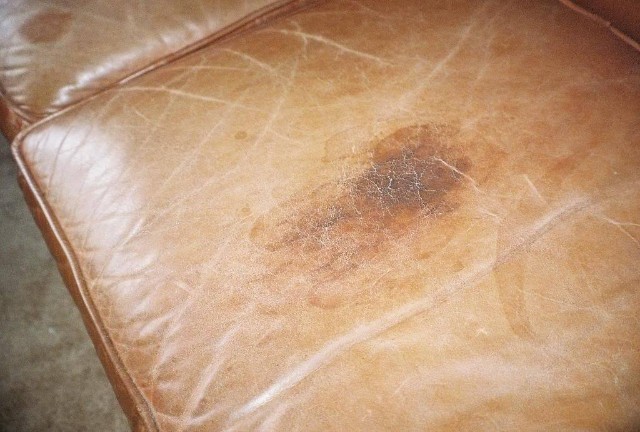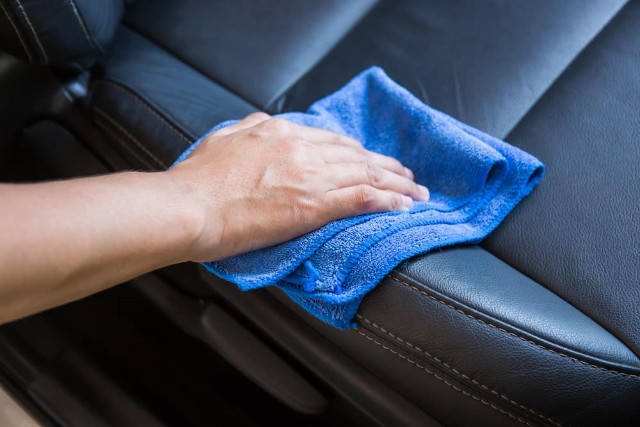Removing the inevitable stains from the leather layer can be a daunting task, but with the right tools and techniques, it doesn’t have to be. From identifying the type of leather to using professional cleansers, I will walk you through all the steps necessary to keep your animal hide looking its best.
With a few simple Nousdecor steps of How To Remove Stains From Leather Furniture, you’ll soon learn how to remove fresh and stubborn stains from any type of animal hide while keeping it in top condition.
Key Takeaways of How To Remove Stains From Leather
- Use proper techniques and products to clean leather items
- Test cleansers on a small area before applying to the entire item
- Avoid abrasive cleansers and stick to mild soap or specialized leather cleansers
- Use soft cloths, like microfiber, to avoid scuffing or scratching the leather surface

Identifying the Type of Leather
Before attempting to remove a stain from leather, it’s important to identify what type of genuine leather sofa options it is. To do this, one should look at the material itself and check if there are any tags indicating the type of animal hide. This will help determine whether the animal hide is genuine or faux as well as its exact composition.
For example, full-grain cowhide is thicker than suede but both can be found in furniture, accessories or apparel. If it is faux leather, check out our article on Faux Leather Sofa Repair instead!
Once you know what kind of animal hide you’re dealing with, you’ll be better equipped to select an appropriate cleaning method for removing the stain without damaging the item.
Additionally, note that certain types of stains may not be removable at all because they have soaked too deeply into the fabric. In such cases, seeking professional help may be necessary in order to restore the original look and feel of your animal hide item.
Now that you’ve identified your animal hide type and determined whether or not a stain can be removed safely, it’s time to move on to learning how to tackle fresh stains on different types of leathers.
Removing Fresh Stains
If you’ve just gotten a fresh stain on your animal hide, it’s important to act quickly. Here are some ways to remove the mark before it sets:
- Blot the area using a clean cloth or paper towel.
- Gently rub in an alcohol-based cleanser made specifically for animal hide.
- Wipe away any excess cleanser and then use another clean cloth to dry.
- For tougher stains, use a soft brush or toothbrush to further work the cleanser into the material.
Make sure not to scrub too harshly as this can damage the animal hide! When done correctly, you should be able to see some improvement in the appearance of the stain after following these steps.
To make sure it is completely gone, however, may require repeating this process several times. And if that doesn’t do it, there are other methods for removing stubborn stains from animal hide that you can try next.
Removing Stubborn Stains
If you’ve tried the methods above but still have a stubborn stain on your animal hide, don’t worry—there are other ways to get rid of it. Try using a damp cloth with mild soap and warm water. Gently scrub the area in circular motions until the stain disappears.
If that doesn’t work, you can use rubbing alcohol or nail polish remover to help loosen the stain. Dip a cotton swab into either solution and then dab onto the affected area. Make sure not to soak the cloth as this could damage your leather item.
Alternatively, try using an eraser specifically designed for removing tough stains from animal hide surfaces. Rub it gently over the stained area until it starts to disappear. Be careful not to rub too hard, however; if you do, it may leave a scratch behind!
Finally, if all else fails, take your animal hide item to a professional cleanser who will be able to provide more specialized advice and treatment options for getting rid of stubborn stains on animal hide items. With their expertise and knowledge, they can help restore your favorite pieces back to their original condition without damaging them further.
Moving forward with using a animal hide cleanser should be done with caution as some cleansers may cause discoloration or fading of certain materials; so make sure you read labels carefully before applying any products yourself!

Using a Leather Cleaner
Using a leather cleanser is a great way to restore your favorite pieces back to their original condition without damaging them further. Here are some tips for using an animal hide cleanser:
- Cleaning the Leather:
- First, dust off any loose particles with a clean cloth or brush.
- Use the cleanser according to the directions on the label and apply it with a soft cloth in circular motions.
- Make sure to test the product on an inconspicuous area of the item before applying it all over.
- Conditioning the Leather:
- After cleaning, use leather to nourish and protect the material.
- Apply small amounts of conditioner at first and work up from there if more is needed.
- Buff away any excess residue that may be left behind with another clean cloth.
Keeping up with regular maintenance can help prevent stubborn stains from forming in the future, such as wiping down after each use with a damp cloth or brushing regularly with a soft-bristled brush.
With proper care, you can keep your favorite leather items looking clean and new for years to come!
Using a Professional Cleaner
Hiring a professional cleanser can be a great way to restore animal hide items and keep them looking new for years. Professional cleansers know the best techniques for removing dirt, grease, and other stains from animal hide without damaging it.
Table 1 below outlines the benefits of using a professional cleanser compared to other methods of stain removal.
| Benefits | DIY | Professional Cleaner |
| Cost Effective | Yes | No |
| Time Investment Required | Moderate – High | Low – Moderate |
| Chance of Damage to Leather Item | Moderate – High | Low – Moderate |
| Quality Results Achieved | Low – High | Moderate – High |
As seen in Table 1, hiring a professional cleanser could be considered more expensive than doing the task yourself but it also comes with reduced chances of damage to your item and higher quality results.
The time investment required is also much lower as professionals have access to specialized equipment that can clean faster than any DIY method. Furthermore, they are knowledgeable about different types of animal hide and what cleaning products should be used on each type so you do not risk damaging your items through trial and error.
In addition to oil stain removal, professionals can also provide advice on how best to maintain clean animal hide over time such as using leathers or avoiding certain products altogether that may cause discolouration or damage in the future.
Transitioning into proper maintenance is essential for extending the life of your animal hide goods.
Maintaining Clean Leather
Maintaining clean animal hide is essential to extending its life and keeping it in pristine condition. Proper cleaning with a mild soap and warm water followed by the application of a suitable animal hide protector will help to keep animal hide looking new.
Regular dusting with a cloth will also go a long way towards preserving the animal hide’s luster. In addition, spot-cleaning any spills or stains immediately can prevent discoloration or damage to the material.
When caring for light-colored animal hide, it is important to use colorless cleansers and polishes as some products may contain dyes that could transfer onto the surface of the material. If you have a white sofa, for example, check out our step-by-step white leather sofa cleaning guide now!
Leather may require conditioning every few months in order to keep it supple and prevent cracking. This can be done using natural oils like mink oil, neatsfoot oil, or lanolin-based creams that are specially designed for conditioning animal hide surfaces.
To apply these oils, you should use a soft rag, wiping away any excess after application so as not to leave an oily residue on the surface of the material.
Taking care of your animal hide items requires diligence but can have great rewards in return: beautiful furniture pieces that last many years and look just as good as they did when you first purchased them!
With regular maintenance and proper cleaning techniques, you can ensure your investment lasts for years to come—without having to resort back to removing ink stain methods again (see pen mark removal from leather sofa). As such, taking precautions now is key when striving for a lifetime of beautiful animal hide pieces.
That said, considerations must also be taken for suede materials which require different maintenance techniques altogether…

Considerations for Suede
When caring for suede, it’s important to keep in mind that it requires special attention. It is more delicate than regular animal hide and can be easily damaged if not properly handled. To get the best results, consider the following points when cleaning or maintaining your suede:
- Cleaning Procedures:
- Treat spills immediately with a dry cloth.
- Blot away moisture with a separate dry cloth.
- Maintenance Tips:
- Use a soft brush to gently remove dirt and debris.
- Apply an appropriate protectant formulated for suede periodically.
No matter how careful you are, accidents may still occur so it’s best to stay ahead of potential damage by taking preventative measures such as avoiding contact with liquids, heat sources, and sharp objects.
With proper care and maintenance, your suede items will look great for years to come! Avoiding damage is key; this means being mindful of how you use and store them too.
Avoiding Damage to Leather
Now that we’ve discussed considerations for removing blots from suede, let’s talk about avoiding damage to animal hide. When cleaning animal hide, it is important to use the proper technique and products so that you don’t end up damaging or discoloring the animal hide instead of removing the stain.
There are a few key points to remember when cleaning your animal hide items:
| Points | Explanation |
| Test First | Always test a small area of the item first before using any type of cleanser. This way you can make sure that it won’t cause damage or discoloration and also get an idea of how much pressure and scrubbing will be required. |
| Use Gentle Cleaners | Avoid abrasive cleansers, such as bleach or other harsh chemical cleansers. Stick with mild soap and water or specialized animal hide cleansers as these are gentle enough to not cause any harm while still being effective at clearing stains. |
| Use Soft Cloths | Always use soft cloths when wiping down your animal hide items as anything too rough might cause scuffing or scratches on the surface. Microfiber cloths work great for this purpose since they are both soft and highly absorbent. |
If done correctly, cleaning your water stained animal hide items should not only restore their original look but also help protect them from further staining in the future. And if done incorrectly, you could end up permanently damaging the item beyond repair. But before giving up, check out our article on repairing torn leather sofa if the need arises!
That’s why it’s crucial to take all necessary precautions when cleaning your animal hide items – do some research beforehand so you know what type of cleanser works best for each specific case and always test a small area first before using any product on your item!
Interested in decorating with leather couches? Check out our articles on how to combine leather sofa with fabric chairs and transforming sofa leather with paint now!
Frequently Asked Questions
Conclusion
Wrapping up, it’s important to remember the old adage “an ounce of prevention is worth a pound of cure.” Regularly maintaining your animal hide goods with appropriate cleaning and conditioning products can help keep them looking their best for many years.
If you do find yourself dealing with a stubborn stain, be sure to test any cleaning product on an inconspicuous part before trying it out on the entire item. Cleaning animal hide can be tricky business, so don’t hesitate to enlist the help of a professional if needed – they know all the tips and tricks for getting your animal hide back in top condition.
Interested in getting your own new couch? Check out our best leather sofa deals to shop your Best Sofa now!




![Chenille vs Microfiber Sofa: Which Is Right For You? [2024]](https://nousdecor.com/wp-content/uploads/2021/06/chenille-vs-microfiber-sofa-300x169.webp)

